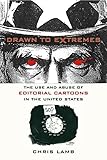Drawn to Extremes : The Use and Abuse of Editorial Cartoons in the United States / Chris Lamb.
Material type: TextPublisher: New York, NY : Columbia University Press, [2004]Copyright date: ©2004Description: 1 online resource (288 p.) : 161 illusContent type:
TextPublisher: New York, NY : Columbia University Press, [2004]Copyright date: ©2004Description: 1 online resource (288 p.) : 161 illusContent type: - 9780231130677
- 9780231534185
- American wit and humor, Pictorial
- Editorial cartoonists -- United States -- Biography
- Editorial cartoons -- United States
- Newspaper publishing -- Political aspects -- United States
- Newspaper publishing -- Political aspects
- Newspaper publishing -- Political aspects -- United States
- Political cartoons
- September 11 Terrorist Attacks, 2001 -- Caricatures and cartoons
- ART / Techniques / Cartooning
- 070.4/42 22
- E183 .L36 2004eb
- online - DeGruyter
- Issued also in print.
| Item type | Current library | Call number | URL | Status | Notes | Barcode | |
|---|---|---|---|---|---|---|---|
 eBook
eBook
|
Biblioteca "Angelicum" Pont. Univ. S.Tommaso d'Aquino Nuvola online | online - DeGruyter (Browse shelf(Opens below)) | Online access | Not for loan (Accesso limitato) | Accesso per gli utenti autorizzati / Access for authorized users | (dgr)9780231534185 |
Frontmatter -- Contents -- Acknowledgments -- 1. "You Should Have Been in the World Trade Center!" -- 2. "President Bush Has Been Reading Doonesbury and Taking It Much Too Seriously" -- 3. "No Honest Man Need Fear Cartoons" -- 4. "McCarthyism" -- 5. "Second-Class Citizens of the Editorial Page" -- 6. "We Certainly Don't Want to Make People Uncomfortable Now, Do We?" -- 7. "That's Not a Definition of Libel; That's a Job Description" -- 8. "Comfort the Afflicted and Afflict the Comfortable" -- Notes -- Index
restricted access online access with authorization star
http://purl.org/coar/access_right/c_16ec
In 2006, a cartoon in a Danish newspaper depicted the Prophet Mohammed wearing a bomb in his turban. The cartoon created an international incident, with offended Muslims attacking Danish embassies and threatening the life of the cartoonist. Editorial cartoons have been called the most extreme form of criticism society will allow, but not all cartoons are tolerated. Unrestricted by journalistic standards of objectivity, editorial cartoonists wield ire and irony to reveal the naked truths about presidents, celebrities, business leaders, and other public figures. Indeed, since the founding of the republic, cartoonists have made important contributions to and offered critical commentary on our society. Today, however, many syndicated cartoons are relatively generic and gag-related, reflecting a weakening of the newspaper industry's traditional watchdog function. Chris Lamb offers a richly illustrated and engaging history of a still vibrant medium that "forces us to take a look at ourselves for what we are and not what we want to be." The 150 drawings in Drawn to Extremes have left readers howling-sometimes in laughter, but often in protest.
Issued also in print.
Mode of access: Internet via World Wide Web.
In English.
Description based on online resource; title from PDF title page (publisher's Web site, viewed 02. Mrz 2022)


